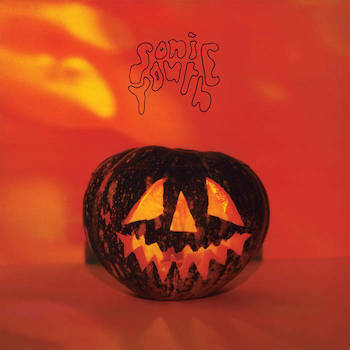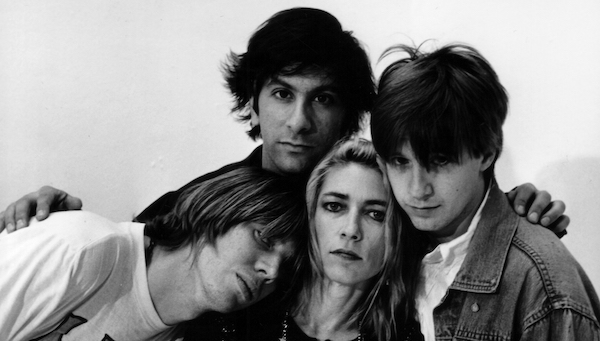Rock Album Review: Sonic Youth’s “Walls Have Ears” — Intimations of Sounds to Come
By Steve Erickson
Sonic Youth’s fans remain passionate enough to justify the release of a slew of live albums.
Sonic Youth, Walls Have Ears (Goofin’)
 1985 marked a turning point for Sonic Youth. The band had begun breaking out of New York with their second album, Bad Moon Rising. They even made a music video for their Lydia Lunch collaboration “Death Valley ’69.” A gleefully gory depiction of the band’s murders inspired by the song’s Manson family references, MTV never would have touched it. Still, the fact that it even exists suggests an attempt to reach a larger audience. The group’s first major breakthrough came the following year when they signed to SST and released Evol, which ushered in a more melodic sound. Bad Moon Rising caught the attention of Cabaret Voltaire manager Paul Smith, who launched the Blast First label to put out in the UK. However, Smith decided it was OK to release — without the band’s permission — Walls Have Ears , a double album of live recordings from 1985. The band was furious about losing control over the release of its music: this is an authentic bootleg, despite being a release from the legit music industry. Over the years, the album has accumulated its own legend. Back in 1994, Eric Weisbard, writing in Spin’s Alternative Record Guide, called it “long past due for an official issue.” 30 years later, following the appearance of 29 live recordings on the band’s Bandcamp page, they’ve finally decided to give Walls Have Ears an authorized release.
1985 marked a turning point for Sonic Youth. The band had begun breaking out of New York with their second album, Bad Moon Rising. They even made a music video for their Lydia Lunch collaboration “Death Valley ’69.” A gleefully gory depiction of the band’s murders inspired by the song’s Manson family references, MTV never would have touched it. Still, the fact that it even exists suggests an attempt to reach a larger audience. The group’s first major breakthrough came the following year when they signed to SST and released Evol, which ushered in a more melodic sound. Bad Moon Rising caught the attention of Cabaret Voltaire manager Paul Smith, who launched the Blast First label to put out in the UK. However, Smith decided it was OK to release — without the band’s permission — Walls Have Ears , a double album of live recordings from 1985. The band was furious about losing control over the release of its music: this is an authentic bootleg, despite being a release from the legit music industry. Over the years, the album has accumulated its own legend. Back in 1994, Eric Weisbard, writing in Spin’s Alternative Record Guide, called it “long past due for an official issue.” 30 years later, following the appearance of 29 live recordings on the band’s Bandcamp page, they’ve finally decided to give Walls Have Ears an authorized release.
1985 also marked a turning point for the electric guitar. The No Wave scene, from which Sonic Youth emerged, pushed the instrument into hitherto unheard territory. (Listen to the hellish racket of Mars’ “Puerto Rican Ghost” or Arto Lindsay’s de-tuned, percussive playing with DNA.) By the middle of the ‘80s these innovations — and the more popular ones coming out of funk and post-punk — were beginning to become old hat. Guitarists Lee Ranaldo and Thurston Moore had already performed in the punk-meets-classical symphonies of composer Glenn Branca but, at this point, Sonic Youth were still recording concise songs. By constantly swapping guitars, each tuned differently, Sonic Youth pressed themselves to invent their own sound. You hear that effort on Walls Have Ears: Moore and Ranaldo’s playing ranges from ferocious rhythm guitar to muted chiming.
Walls Have Ears has not been edited or sequenced for maximum impact. It has, in fact, been assembled with a distinctly prankish spirit. (The photo of a pumpkin on the cover alludes to “Halloween,” the B-side of their single “Flower.”) The album includes a two-minute rant from music critic Claude Bessy – not something most people would listen to more than once. Several songs are included twice, under different names: “Spahn Ranch Dance” is an alternate take of “Death Valley ’69,” while “Killed and Kicked Off” is really “Kill Yr. Idols.” “I’m Insane” went unlisted on the original release. Still, though Walls Have Ears will always sound frayed – “Blood on Brighton Beach” might have been recorded on a fan’s Walkman — the quality of this reissue is a big improvement over the vinyl rips of the original bootleg found on YouTube.

Sonic Youth, circa 1985. Photo: Wiki Common
Taking the time to stretch out, the developments in the band’s songwriting are evident. They worked short, tuneful passages into extended jamming. Rather than playing solos, Ranaldo and Moore traded off trebly noise riffs for minutes on end. “Expressway To Yr Skull,” also included in two versions, typifies this creative method. The first few minutes begin as a relatively conventional song, almost turning “mystery train, three-way plane/expressway to yr. skull” into a chorus. But the band goes on from there to stretch the song out for another six minutes. Despite the band’s reputation for aggressive noise, they turned quiet moments into eerie ones. For example, the ending of “Expressway To Yr. Skull” dares you to think the song’s over before it returns to a faint hum. Parts of Walls Have Ears deliver a bleak version of ambient music, aiming for tinnitus rather than distraction.
The band’s references to Manson were as affected as their choice to abbreviate “your” to “yr.” in their song titles. Yet the harrowing live versions of “Death Valley ‘69” transcend edgelord posturing. It’s a murder ballad about the compulsion to commit violence. The tune’s rhythm and structure push relentlessly towards its central horror: “she started to holler/I didn’t wanna/but I had to hit it.” Moore’s frenzied narrator desperately tries to deny his own impulses and behavior. Singer/bassist Kim Gordon’s feminist perspective, expressed most directly on “Flower,” provided a healthy alternative to the brutality towards women described by “Death Valley ‘69.”
Sonic Youth’s fans remain passionate enough to justify the release of a slew of live albums. Walls Have Ears displays the talents of a band that could’ve faded into distant memory (like their post-No Wave peers Ut and Live Skull), but who had the artistic ambition to keep reinventing their sound. This album works as a de facto compilation of the best songs they’d written by 1985, thus offering a glimpse into what would be an even more substantial future.
Steve Erickson writes about film and music for Gay City News, Slant Magazine, the Nashville Scene, Trouser Press, and other outlets. He also produces electronic music under the tag callinamagician. His latest album, Bells and Whistles, was released in January 2024, and is available to stream here.
Tagged: Kim Gordon, Lee Ranaldo, Sonic Youth, Thurston Moore


Live Skull is still together and releasing great music!